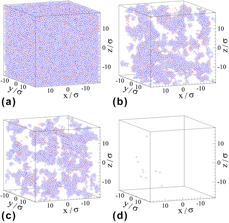Article contents
Potential energy states and mechanical properties of thermally cycled binary glasses
Published online by Cambridge University Press: 30 April 2019
Abstract

The influence of repeated thermal cycling on mechanical properties, structural relaxation, and evolution of the potential energy in binary glasses is investigated using molecular dynamics simulations. The authors consider a binary mixture annealed with different cooling rates and then exposed to one thousand thermal cycles at constant pressure. It is found that during the first few hundred transient cycles, the potential energy minima after each cycle gradually decrease and the structural relaxation proceeds through collective, irreversible displacements of atoms. With increasing cycle number, the amplitudes of the volume and potential energy oscillations are significantly reduced, and the potential energy minima saturate to a constant value that depends on the thermal cycling amplitude and the initial cooling rate. In the steady state, the glasses thermally expand and contract but most of the atoms return to their cages after each cycle, similar to limit cycles found in periodically driven amorphous materials. The results of tensile tests demonstrate that the elastic modulus and the yielding peak, evaluated after the thermal treatment, acquire maximum values at a particular thermal cycling amplitude, which coincides with the minimum of the potential energy.
- Type
- Article
- Information
- Copyright
- Copyright © Materials Research Society 2019
References
- 14
- Cited by





